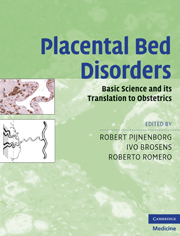24 results
8 - Trophoblast invasion and uterine artery remodelling in primates
-
-
- Book:
- The Placenta and Human Developmental Programming
- Published online:
- 04 February 2011
- Print publication:
- 16 December 2010, pp 92-101
-
- Chapter
- Export citation
Contributors
-
-
- Book:
- The Placenta and Human Developmental Programming
- Published online:
- 04 February 2011
- Print publication:
- 16 December 2010, pp vii-x
-
- Chapter
- Export citation
Chapter 4 - What is defective:
- from Section 2: - Placental bed vascular disorders
-
-
- Book:
- Placental Bed Disorders
- Published online:
- 06 July 2010
- Print publication:
- 03 June 2010, pp 22-28
-
- Chapter
- Export citation
Preface
-
- Book:
- Placental Bed Disorders
- Published online:
- 06 July 2010
- Print publication:
- 03 June 2010, pp xiii-xiv
-
- Chapter
- Export citation

Placental Bed Disorders
- Basic Science and its Translation to Obstetrics
-
- Published online:
- 06 July 2010
- Print publication:
- 03 June 2010
Copyright page
-
- Book:
- Placental Bed Disorders
- Published online:
- 06 July 2010
- Print publication:
- 03 June 2010, pp iv-iv
-
- Chapter
- Export citation
Chapter 11 - Deep trophoblast invasion and spiral artery remodeling
- from Section 4: - Deep placentation
-
-
- Book:
- Placental Bed Disorders
- Published online:
- 06 July 2010
- Print publication:
- 03 June 2010, pp 97-108
-
- Chapter
- Export citation
Section 6: - Genetics
-
- Book:
- Placental Bed Disorders
- Published online:
- 06 July 2010
- Print publication:
- 03 June 2010, pp 165-194
-
- Chapter
- Export citation
Section 8: - Translation to obstetrics
-
- Book:
- Placental Bed Disorders
- Published online:
- 06 July 2010
- Print publication:
- 03 June 2010, pp 243-289
-
- Chapter
- Export citation
Section 7: - Risk factors, predictors, and future management
-
- Book:
- Placental Bed Disorders
- Published online:
- 06 July 2010
- Print publication:
- 03 June 2010, pp 195-242
-
- Chapter
- Export citation
Section 2: - Placental bed vascular disorders
-
- Book:
- Placental Bed Disorders
- Published online:
- 06 July 2010
- Print publication:
- 03 June 2010, pp 11-28
-
- Chapter
- Export citation
Index
-
- Book:
- Placental Bed Disorders
- Published online:
- 06 July 2010
- Print publication:
- 03 June 2010, pp 290-301
-
- Chapter
- Export citation
Chapter 1 - The placental bed in a historical perspective
- from Section 1: - Introducing the placental bed
-
-
- Book:
- Placental Bed Disorders
- Published online:
- 06 July 2010
- Print publication:
- 03 June 2010, pp 1-4
-
- Chapter
- Export citation
Section 1: - Introducing the placental bed
-
- Book:
- Placental Bed Disorders
- Published online:
- 06 July 2010
- Print publication:
- 03 June 2010, pp 1-10
-
- Chapter
- Export citation
Chapter 13 - Animal models of deep trophoblast invasion
- from Section 5: - Comparative anatomy and research models
-
-
- Book:
- Placental Bed Disorders
- Published online:
- 06 July 2010
- Print publication:
- 03 June 2010, pp 127-139
-
- Chapter
- Export citation
Placental Bed Disorders - Title page
-
-
- Book:
- Placental Bed Disorders
- Published online:
- 06 July 2010
- Print publication:
- 03 June 2010, pp iii-iii
-
- Chapter
- Export citation
Dedication
-
- Book:
- Placental Bed Disorders
- Published online:
- 06 July 2010
- Print publication:
- 03 June 2010, pp v-vi
-
- Chapter
- Export citation
Contents
-
- Book:
- Placental Bed Disorders
- Published online:
- 06 July 2010
- Print publication:
- 03 June 2010, pp vii-viii
-
- Chapter
- Export citation
Section 3: - Uterine vascular environment
-
- Book:
- Placental Bed Disorders
- Published online:
- 06 July 2010
- Print publication:
- 03 June 2010, pp 29-74
-
- Chapter
- Export citation
Contributors
-
-
- Book:
- Placental Bed Disorders
- Published online:
- 06 July 2010
- Print publication:
- 03 June 2010, pp ix-xii
-
- Chapter
- Export citation



